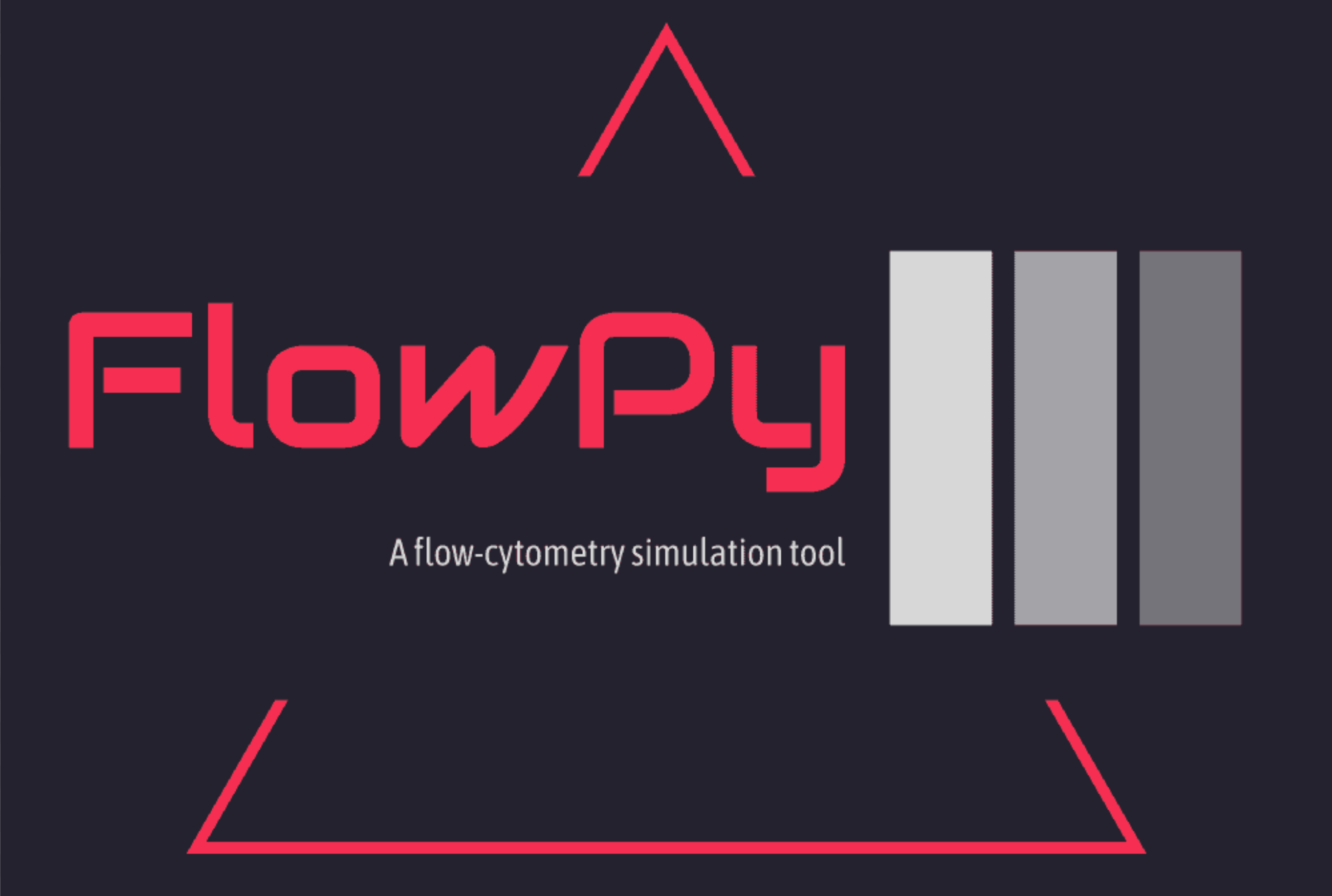A package for flow-cytometry simulations.
Project description
Meta |
|||
Testing |
|||
PyPi |
Overview
FlowCyPy is a robust Python package designed to simulate the behavior of a flow cytometer. By simulating realistic Forward Scatter (FSC) and Side Scatter (SSC) signals—complete with noise, baseline shifts, and signal saturation—FlowCyPy provides a detailed model of flow cytometry experiments. Ideal for researchers and engineers, it offers an intuitive and configurable platform for studying scattering phenomena and detector responses in flow cytometry setups.
Features
Particle Event Simulation: Generate realistic FSC and SSC signals with configurable parameters.
Noise & Baseline Shift Modeling: Add Gaussian noise and baseline shifts to simulate real-world experimental conditions.
Signal Saturation: Simulate detector saturation to reflect real-life limitations.
Signal Digitization: Discretize continuous signals into specified bins for deeper analysis.
Advanced Plotting: Customize signal visualization with multi-channel plot support.
Fully Configurable: Customize particle size distributions, flow parameters, and detector setups.
Installation
You can easily install FlowCyPy via pip:
pip install FlowCyPyRequirements
FlowCyPy requires Python 3.10 or higher and the following dependencies:
numpy
scipy
pint
tabulate
seaborn
MPSPlots
PyMieSim
pydantic>=2.6.3
Quick Start Example
Below is an example of how to simulate particle events and generate flow cytometry signals using FlowCyPy:
import numpy as np
from FlowCyPy import FlowCytometer, Scatterer, Analyzer, Detector, Source, FlowCell
from FlowCyPy import distribution
from FlowCyPy import peak_finder
from FlowCyPy.units import particle, milliliter, nanometer, RIU, second, micrometer, millisecond, meter
np.random.seed(3)
flow_cell = FlowCell(
flow_speed=7.56 * meter / second,
flow_area=(10 * micrometer) ** 2,
run_time=0.1 * millisecond
)
scatterer = Scatterer(medium_refractive_index=1.33 * RIU)
scatterer.add_population(
name='EV',
concentration=2e+9 * particle / milliliter / 10,
size=distribution.RosinRammler(
characteristic_size=50 * nanometer,
spread=10.5
),
refractive_index=distribution.Normal(
mean=1.45 * RIU,
std_dev=0.02 * RIU
)
)
scatterer.initialize(flow_cell=flow_cell)
scatterer.print_properties()
scatterer.plot()
from FlowCyPy.units import milliwatt, AU
source = Source(
numerical_aperture=0.3 * AU,
wavelength=800 * nanometer,
optical_power=100 * milliwatt
)
source.print_properties() # Print the laser source properties
# Step 5: Configure Detectors
# Side scatter detector
from FlowCyPy.units import degree, watt, ampere, millivolt, ohm, kelvin, milliampere, megahertz
detector_0 = Detector(
name='side',
phi_angle=90 * degree,
numerical_aperture=1.2 * AU,
responsitivity=1 * ampere / watt,
sampling_freq=60 * megahertz,
saturation_level=1 * millivolt,
n_bins='16bit',
resistance=50 * ohm,
dark_current=0.1 * milliampere,
temperature=300 * kelvin
)
# Forward scatter detector
detector_1 = Detector(
name='forward',
phi_angle=0 * degree,
numerical_aperture=1.2 * AU,
responsitivity=1 * ampere / watt,
sampling_freq=60 * megahertz,
saturation_level=1 * millivolt,
n_bins='16bit',
resistance=50 * ohm,
dark_current=0.1 * milliampere,
temperature=300 * kelvin
)
detector_1.print_properties()
cytometer = FlowCytometer(
coupling_mechanism='mie',
source=source,
scatterer=scatterer,
detectors=[detector_0, detector_1]
)
cytometer.simulate_pulse()
cytometer.plot()The plot produced will resemble the following:
Developer Guide
For developers or contributors who want to work on FlowCyPy, follow the steps below to install the package locally, run tests, and build the documentation.
### 1. Clone the Repository
First, clone the repository:
git clone https://github.com/MartinPdeS/FlowCyPy.git
cd FlowCyPy### 2. Install Locally
Install the package in editable mode along with the testing and documentation dependencies:
pip install -e .[testing,documentation]### 3. Running Tests
To run the tests, use pytest with coverage:
pytestThis will generate a coverage report in htmlcov/index.html.
### 4. Building Documentation
To build the documentation locally using Sphinx, follow these steps:
cd docs
make htmlOnce completed, the HTML documentation will be available in the docs/_build/html directory.
Additional Examples
Explore a variety of use cases and configurations in the Examples section of the documentation, including:
Density Plots for Large and Small Scatterers
Raw Signal as measured from the detector
Peak finder analysis
Scatter Density Plot
Contributions
FlowCyPy is under active development, and contributions are highly encouraged! Feel free to reach out for collaboration opportunities or to provide feedback.
Contact Information
As of 2024, the project is still under development. If you want to collaborate, it would be a pleasure! I encourage you to contact me.
FlowCell was written by Martin Poinsinet de Sivry-Houle .
Project details
Release history Release notifications | RSS feed
Download files
Download the file for your platform. If you're not sure which to choose, learn more about installing packages.
Source Distribution
Built Distribution
File details
Details for the file flowcypy-0.2.9.1.tar.gz.
File metadata
- Download URL: flowcypy-0.2.9.1.tar.gz
- Upload date:
- Size: 3.6 MB
- Tags: Source
- Uploaded using Trusted Publishing? No
- Uploaded via: twine/5.1.1 CPython/3.9.20
File hashes
| Algorithm | Hash digest | |
|---|---|---|
| SHA256 | 62ee361fe6711100b29f22b7e6feb27756889adb6219a464eddc6fd5bc66ab61 |
|
| MD5 | 2e3ff62534f70a1f48f54e5d269964b4 |
|
| BLAKE2b-256 | 6efdaabb46d9d5b63464fc666cc2b6059f7697099474579f27ee9f4fd56b25aa |
File details
Details for the file FlowCyPy-0.2.9.1-py3-none-any.whl.
File metadata
- Download URL: FlowCyPy-0.2.9.1-py3-none-any.whl
- Upload date:
- Size: 51.7 kB
- Tags: Python 3
- Uploaded using Trusted Publishing? No
- Uploaded via: twine/5.1.1 CPython/3.9.20
File hashes
| Algorithm | Hash digest | |
|---|---|---|
| SHA256 | fb06efb96b28f0566b99b32ce5032827e4dbd129c9dade286226fc4b4f65b291 |
|
| MD5 | 091bfbca6212cd02d7f9b52884902900 |
|
| BLAKE2b-256 | 3d7a45b3d2a3be40de7543ab08e38cd4c606d59d3030cdd6a6e47e48f36aa833 |























